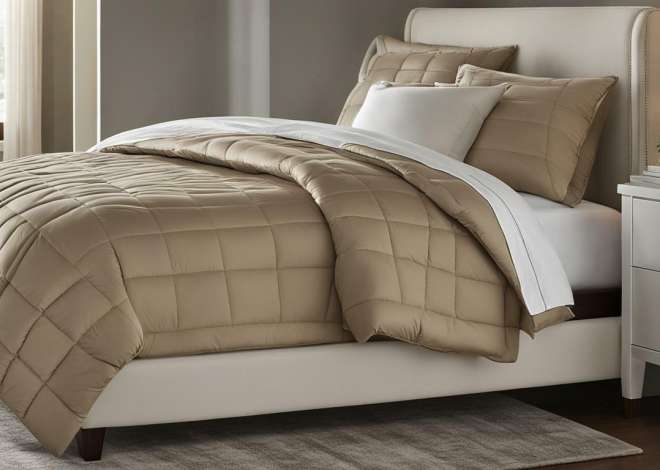
Can You Wash Bamboo Pillows
Many people are turning to bamboo pillows for a comfortable and eco-friendly sleep experience. But when it comes to keeping these pillows clean, there seems to be a lot of confusion. Can you wash bamboo pillows? In this article, we will discuss everything you need to know about washing your bamboo pillows and keeping them in good condition.
Understanding Bamboo Pillows
Bamboo pillows are becoming increasingly popular due to their unique properties and benefits. Made from bamboo-derived materials, such as the outer cover or the filling, these pillows offer a range of advantages that make them stand out from traditional pillows.
What are Bamboo Pillows?
Bamboo pillows are not just your ordinary pillows. They are crafted using bamboo-derived materials, which contribute to their exceptional qualities. The outer cover and filling of these pillows are made from bamboo fibers, resulting in a soft and luxurious feel.
But why bamboo? Bamboo is a sustainable and eco-friendly material that has gained recognition in various industries. It is known for its natural hypoallergenic properties, making it an ideal choice for those with sensitive skin or allergies. Bamboo pillows offer a safe and comfortable sleeping environment, allowing you to wake up feeling refreshed and rejuvenated.
Benefits of Bamboo Pillows
The benefits of bamboo pillows extend beyond their hypoallergenic nature. One of the standout features of these pillows is their ability to regulate temperature effectively. Bamboo is naturally breathable and can wick away moisture, ensuring that you stay cool and comfortable throughout the night. No more waking up in a sweat or constantly flipping your pillow to find the cool side!
Bamboo pillows are also highly durable and long-lasting. The bamboo fibers used in their construction are known for their strength and resilience, ensuring that your pillow will maintain its shape and support for an extended period. Say goodbye to flat and lifeless pillows!
In addition to their temperature-regulating and durability properties, bamboo pillows are also resistant to dust mites. Dust mites are microscopic creatures that can trigger allergies and respiratory issues. By choosing a bamboo pillow, you can create a healthier sleeping environment and reduce the risk of these pesky critters making a home in your pillow.
Furthermore, bamboo pillows are naturally antimicrobial, meaning they inhibit the growth of bacteria and other harmful microorganisms. This feature adds an extra layer of cleanliness and hygiene to your sleeping experience.
Overall, bamboo pillows offer a multitude of benefits that make them a worthy investment. From their hypoallergenic and temperature-regulating properties to their durability and resistance to dust mites, these pillows provide a luxurious and healthy sleep environment. So, why settle for ordinary pillows when you can experience the exceptional comfort and benefits of bamboo pillows?
The Debate: Can Bamboo Pillows Be Washed?
When it comes to washing bamboo pillows, it is essential to follow the manufacturer’s instructions. Some bamboo pillows may have specific care guidelines that need to be followed to ensure their longevity. These instructions can usually be found on the pillow’s tag or packaging.
However, it is important to note that not all bamboo pillows are created equal. Some may be made with a blend of bamboo and other materials, while others may be made entirely of bamboo. This can affect the washing instructions and care needed for each type of pillow.
For pillows made with a blend of bamboo and other materials, it is recommended to check the care label for specific instructions. In most cases, these pillows can be machine-washed on a gentle cycle with mild detergent. It is advisable to use cold water and avoid using bleach or harsh chemicals that can damage the bamboo fibers.
On the other hand, pillows made entirely of bamboo may require more delicate care. These pillows are often filled with shredded bamboo fibers, which can be damaged if not handled properly. In such cases, it is best to follow the manufacturer’s instructions carefully.
Common Misconceptions about Washing Bamboo Pillows
There are a few misconceptions when it comes to washing bamboo pillows. Some people believe that bamboo pillows cannot be washed at all, while others think they can be machine-washed without any special care. The truth lies somewhere in between.
While it is true that bamboo pillows can be washed, it is important to do so with caution. The delicate nature of bamboo fibers requires gentle handling to maintain their integrity and prolong the lifespan of the pillow.
One common misconception is that bamboo pillows cannot be machine-washed. While it is true that some bamboo pillows may require hand-washing or spot-cleaning, many can be safely washed in a machine. However, it is crucial to use a gentle cycle and mild detergent to avoid damaging the bamboo fibers.
Another misconception is that bamboo pillows do not need special care when it comes to washing. While bamboo is naturally antimicrobial and resistant to dust mites, proper cleaning is still necessary to remove dirt, oils, and allergens that can accumulate over time.
It is also worth noting that bamboo pillows may require longer drying times compared to other types of pillows. This is because bamboo fibers tend to retain moisture, and thorough drying is essential to prevent the growth of mold or mildew.
In conclusion, while bamboo pillows can be washed, it is crucial to follow the manufacturer’s instructions and exercise caution. Each pillow may have specific care guidelines based on its composition, and it is important to understand and adhere to these instructions to ensure the longevity and cleanliness of your bamboo pillow.
Step-by-Step Guide to Washing Bamboo Pillows
Preparing Your Bamboo Pillow for Washing
Before you wash your bamboo pillow, it is crucial to remove the cover and check for any stains or spots. If there are any visible stains, you can treat them with a mild detergent or stain remover. It is also a good idea to check the care instructions on the pillow’s tag or packaging to ensure you are following the correct washing method.
Once you have removed the cover and inspected the pillow, take a moment to appreciate the natural beauty of bamboo. Bamboo is a sustainable and eco-friendly material that is known for its strength and durability. It is also hypoallergenic, making it an excellent choice for those with allergies or sensitive skin.
Now that you have familiarized yourself with the unique qualities of bamboo, let’s move on to the washing process.
Washing Process for Bamboo Pillows
When it comes to washing the bamboo pillow itself, it is recommended to hand wash it. Fill a basin with lukewarm water and add a gentle detergent. Gently submerge the pillow and agitate it to remove any dirt or stains. As you do this, imagine the water cleansing away any impurities and leaving your pillow fresh and clean.
While you wash the pillow, take a moment to think about the journey it has been on. From the bamboo forests where it was harvested to the manufacturing process that transformed it into a comfortable pillow, each step has contributed to its quality and comfort.
After washing, rinse the pillow thoroughly to remove any soap residue. Imagine the clear water flowing over the pillow, carrying away any remaining traces of detergent. This step ensures that your pillow will be free from any chemicals that could irritate your skin or affect your sleep.
If your bamboo pillow is machine washable, you can place it in a front-loading washing machine on the gentle cycle. Use a mild detergent and cold water. Avoid using bleach or harsh chemicals as they can damage the bamboo fibers. As the machine gently cleans your pillow, envision it being surrounded by a gentle and soothing whirlpool of water.
Drying Your Bamboo Pillow
After washing, it is important to dry your bamboo pillow properly. You can air dry it by laying it flat on a clean towel or hanging it outside. As the pillow dries naturally, picture the gentle breeze and warm sunlight enhancing the freshness of the bamboo fibers.
Avoid exposing the pillow to direct sunlight as it can fade the color. Bamboo has a natural beauty that you want to preserve, so it’s best to keep it away from harsh UV rays. Instead, find a shady spot where your pillow can dry peacefully.
Ensure that the pillow is completely dry before putting it back on your bed. You can gently squeeze the pillow to check for any remaining moisture. If it feels damp, give it a little more time to dry. Patience is key when it comes to caring for your bamboo pillow.
If you prefer machine drying, use a low heat setting or the delicate cycle. Add a few tennis balls or clean sneakers to the dryer to help fluff the pillow as it dries. The gentle bouncing of the tennis balls mimics the motion of hand fluffing, ensuring that your pillow remains plump and comfortable.
Monitor the drying process closely to prevent over-drying or shrinkage. As you do so, take a moment to appreciate the care and attention you are giving to your bamboo pillow. By following these washing and drying instructions, you are ensuring that your pillow will continue to provide you with a restful and rejuvenating sleep for years to come.
Tips for Maintaining Your Bamboo Pillow
Having a bamboo pillow can greatly enhance your sleep experience, providing you with comfort and support throughout the night. However, to ensure that your bamboo pillow remains in optimal condition, it is important to follow some regular cleaning practices and know when it’s time to replace it.
Regular Cleaning Practices
Keeping your bamboo pillow clean and fresh is essential for a healthy sleep environment. By following these regular cleaning practices, you can prolong the life of your pillow:
- Using a pillow protector: Investing in a high-quality pillow protector is a wise decision. Not only does it act as a barrier against stains and dirt accumulation, but it also helps to extend the lifespan of your bamboo pillow.
- Regularly washing the pillowcase and pillow protector: It is recommended to wash your pillowcase and pillow protector at least once every two weeks. This helps to remove any sweat, oils, or allergens that may have accumulated on the surface.
- Vacuuming the pillow: Over time, dust and debris can settle on your bamboo pillow. To remove these particles effectively, use a handheld vacuum attachment to gently vacuum the surface of the pillow. This will help maintain its cleanliness and prevent any potential allergic reactions.
- Fluffing the pillow regularly: Bamboo pillows are designed to provide optimal support and comfort. To ensure that it maintains its shape and loft, it is important to fluff the pillow regularly. Simply give it a good shake or knead it gently to redistribute the filling and restore its original form.
When to Replace Your Bamboo Pillow
While bamboo pillows are known for their durability, they will eventually show signs of wear and tear over time. Here are some indications that it may be time to replace your bamboo pillow:
- Lumpy or flat appearance: If you notice that your bamboo pillow has become uneven or flat, it may no longer provide the necessary support for your head and neck. This can lead to discomfort and restless nights.
- Uncomfortable sleep: Your pillow should provide you with a comfortable and restful sleep experience. If you find yourself waking up with aches, pains, or stiffness, it could be a sign that your bamboo pillow is no longer suitable for your needs.
- Discoloration or fraying: Over time, the fabric of your bamboo pillow may start to show signs of discoloration or fraying. This can be an indication that the pillow is reaching the end of its lifespan and may not be as hygienic as it once was.
- Unpleasant odor: Even after washing, if your bamboo pillow starts to emit an unpleasant odor, it is a clear sign that it needs to be replaced. This odor could be a result of bacteria or mold growth within the pillow, which can negatively impact your sleep quality and overall health.
By being mindful of these cleaning practices and knowing when to replace your bamboo pillow, you can ensure that you continue to enjoy the benefits of a comfortable and supportive sleep surface for years to come.
Frequently Asked Questions about Bamboo Pillows
Can Bamboo Pillows Cause Allergies?
Bamboo pillows are hypoallergenic and resistant to dust mites, making them a great option for those with allergies or respiratory issues. However, individual sensitivities may vary, and some people may still experience allergies to certain materials used in the pillow. If you have severe allergies, it is essential to consult with a healthcare professional before using any new bedding products.
Are Bamboo Pillows Eco-Friendly?
Yes, bamboo pillows are considered to be eco-friendly. Bamboo is a sustainable resource that grows quickly without the need for pesticides or fertilizers. Additionally, bamboo fabrics are biodegradable and can decompose naturally, reducing their impact on the environment.
FAQs (Frequently Asked Questions)
Q: How often should I wash my bamboo pillow?
A: It is recommended to wash your bamboo pillow every 2-3 months, or as needed. Regular cleaning practices, such as using a pillow protector and washing the pillowcase, can help maintain its cleanliness between washes.
Q: Can I use fabric softener when washing my bamboo pillow?
A: It is best to avoid using fabric softener when washing your bamboo pillow. Fabric softener can leave a residue on the bamboo fibers, affecting their natural properties and reducing their breathability.
Q: Can I spot clean my bamboo pillow?
A: Yes, you can spot clean your bamboo pillow if you notice any stains or spills. Use a mild detergent or stain remover and gently blot the affected area. Avoid rubbing or scrubbing the stain, as it can push it further into the fabric.
Q: Can I bleach my bamboo pillow?
A: It is not recommended to bleach your bamboo pillow. Bleach can damage the bamboo fibers and cause discoloration. Stick to gentle detergents and avoid using bleach or harsh chemicals.
Q: Can I dry clean my bamboo pillow?
A: Dry cleaning is not necessary for bamboo pillows. They can be hand washed or machine washed using the proper care instructions. Dry cleaning chemicals may be too harsh for the bamboo fibers and can affect their quality and performance.
Q: Can I use a dryer sheet when drying my bamboo pillow?
A: It is best to avoid using dryer sheets when drying your bamboo pillow. Dryer sheets can leave a residue on the pillow and affect its natural properties, such as breathability and moisture-wicking capabilities.
Q: Can I iron my bamboo pillow?
A: It is not recommended to iron your bamboo pillow. The heat from the iron can damage the bamboo fibers and cause them to lose their natural properties.
Q: Can I store my bamboo pillow in a vacuum bag?
A: It is not recommended to store your bamboo pillow in a vacuum bag. Vacuum bags can compress the pillow and affect its shape and loft. It is best to store your bamboo pillow in a breathable storage bag or pillowcase to maintain its quality.
Conclusion
So, can you wash bamboo pillows? Yes, you can wash bamboo pillows with proper care and attention. It is important to follow the manufacturer’s instructions and use the appropriate washing method to ensure the longevity of your pillow. Regular cleaning practices and proper maintenance will help keep your bamboo pillow clean, fresh, and comfortable for years to come.


